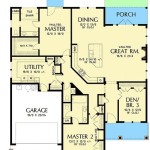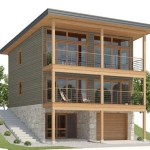Simple Floor Plan Samples With Dimensions: A Comprehensive Guide
A floor plan, at its core, is a scaled diagram of a room or building viewed from above. It illustrates the relationships between rooms, spaces, and other physical features at one level of a structure. These plans often include dimensions, wall lengths, window and door locations, and sometimes even furniture layouts. While architects and designers use sophisticated software to create complex blueprints, understanding simple floor plan examples with dimensions provides valuable insights for homeowners, renters, and anyone interested in space planning.
This article examines several simple floor plan samples with dimensions, focusing on key elements and providing a comprehensive understanding of how to interpret and utilize them. It delves into the purpose of each dimension, the standard conventions used, and the practical applications of these plans in various scenarios.
Understanding the Basic Elements of a Floor Plan
Before delving into specific examples, it's crucial to understand the common elements found in most floor plans. This knowledge forms the foundation for accurately interpreting the dimensions and overall layout.
Walls: Walls are typically represented by thick lines, delineating the boundaries of rooms and the external limits of the building. The thickness of the line can sometimes indicate the type of wall (e.g., load-bearing or partition wall). Dimensions are usually provided for wall lengths and thicknesses.
Doors and Windows: Doors are depicted as arcs indicating the swing direction and the opening width. Windows are often represented as two or three parallel lines within the wall, with the space between them showing the window's width. Dimensions are usually provided for both the door opening and the window width and height (sometimes including sill height).
Rooms: Each room is clearly defined within the floor plan, and its name (e.g., "Bedroom," "Living Room," "Kitchen") is typically labelled inside the room. Dimensions are usually provided for the overall length and width of the room.
Fixtures and Appliances: Floor plans often include representations of major fixtures, such as toilets, sinks, bathtubs, and appliances (e.g., refrigerators, stoves, washing machines). These are generally drawn to scale and can help visualize the space's functionality. While dimensions are not always provided for these individual items, their placement within the room helps understand spatial constraints.
Dimensions: Dimensions are arguably the most critical aspect of a floor plan. They provide precise measurements for different elements, enabling accurate planning and execution of renovations or furniture arrangements. These dimensions are typically expressed in feet and inches (e.g., 12'-6" for 12 feet and 6 inches) or in metric units (e.g., meters and centimeters). Dimensions are usually indicated by extension lines extending from the measured element, with a dimension line connecting them and the measurement written above or below the dimension line.
Furthermore, it is important to distinguish between "inside" and "outside" dimensions. Inside dimensions measure the distance between interior walls, crucial for calculating usable floor space. Outside dimensions measure the overall footprint of the building, useful for property line considerations and site planning.
Analyzing Simple Floor Plan Samples with Dimensions
Let's examine a few simplified floor plan samples, focusing on the significance of the dimensions provided:
Sample 1: A Studio Apartment Floor Plan
A typical studio apartment floor plan might include a single large room encompassing the living, sleeping, and dining areas, along with a separate bathroom and a small kitchen area. Dimensions in such a floor plan would be crucial for determining optimal furniture placement.
The overall dimensions of the main living area might be 20'-0" x 15'-0". This indicates a rectangular space of 20 feet in length and 15 feet in width. The bathroom, typically smaller, might measure 8'-0" x 5'-0". The kitchen area, often integrated into one wall of the main room, could be 8'-0" in length. The dimensions of the windows would specify their width (e.g., 4'-0") and their height (e.g., 3'-0"), as well as their distance from the corners of the room.
These dimensions would allow a tenant to plan the layout effectively. For example, knowing the main room's dimensions, they could determine the size of the sofa, bed, and dining table that would fit comfortably without overcrowding the space. The bathroom dimensions dictate the size of the vanity and storage options. The kitchen dimensions help in choosing appliances and determining counter space.
Sample 2: A One-Bedroom Apartment Floor Plan
A one-bedroom apartment offers more defined spaces, including a separate bedroom, living room, kitchen, and bathroom. The floor plan would, therefore, include dimensions for each of these rooms.
The living room might measure 14'-0" x 12'-0", while the bedroom could be 12'-0" x 10'-0". The kitchen, potentially separate from the living room, might be 8'-0" x 7'-0". The bathroom could be similar to the studio apartment, at 8'-0" x 5'-0". In addition to the room dimensions, the floor plan would also include dimensions for doorways (e.g., 3'-0" wide) and hallways (e.g., 3'-6" wide).
Analyzing these dimensions allows for a more detailed understanding of the space. The larger living room provides more flexibility in furniture arrangement compared to the studio apartment. The separate bedroom allows for more privacy. The hallway dimensions are critical for ensuring ease of movement between rooms and accommodating furniture during relocation.
Sample 3: A Small Office Floor Plan
A small office space floor plan provides a simplified example for commercial applications. It would typically include a main working area, a reception space, and potentially a small storage or utility room.
The main working area might measure 18'-0" x 15'-0". The reception area could be 10'-0" x 8'-0". The storage room might be 6'-0" x 4'-0". The floor plan would also specify the location of electrical outlets, which is crucial for setting up computers and other office equipment. The dimensions of the entrance door and any interior doors would be indicated.
For an office, these dimensions are vital for determining the number of desks that can be accommodated in the main working area, the size of the reception furniture, and the storage capacity of the utility room. Furthermore, the location of electrical outlets needs to be considered alongside the furniture layout to ensure convenient access to power.
Practical Applications of Floor Plans with Dimensions
Understanding and interpreting floor plans with dimensions has numerous practical applications, benefiting various stakeholders.
Homeowners: Homeowners can use floor plans with dimensions to plan renovations, redecorate, or purchase new furniture. By accurately measuring their existing spaces and comparing them to the floor plan, they can make informed decisions about furniture size, placement, and the feasibility of structural changes.
Renters: Renters can use floor plans to assess the suitability of a potential apartment or house. The dimensions allow them to determine if their existing furniture will fit comfortably and to plan the layout of their belongings before moving in, avoiding potential surprises and logistical challenges.
Real Estate Professionals: Real estate agents use floor plans with dimensions to market properties effectively. Providing prospective buyers or renters with detailed floor plans can help them visualize the space and understand its potential, leading to increased interest and faster sales or rentals.
Interior Designers: Interior designers rely heavily on floor plans with dimensions to create functional and aesthetically pleasing spaces. They use these plans to develop furniture layouts, select materials, and coordinate with contractors. Accurate dimensions are essential for ensuring that the design is implemented correctly.
Contractors: Contractors use floor plans with dimensions to build or renovate structures according to the specified design. These plans provide the necessary information for accurate material estimation, layout, and construction. Any discrepancies in the dimensions can lead to costly errors and delays. Thus, floor plans are an essential communication tool for contractors.
Furthermore, understanding floor plans with dimensions is essential for accessibility compliance. Dimensions ensure that doorways, hallways, and bathrooms meet the minimum requirements for wheelchair access and other mobility aids.
In summary, simple floor plan samples with dimensions provide a valuable tool for understanding and planning spaces. The ability to interpret these plans accurately empowers individuals to make informed decisions about their homes, offices, and other environments. By understanding the basic elements, analyzing sample plans, and recognizing the practical applications, anyone can leverage this knowledge for a variety of purposes.

12 Examples Of Floor Plans With Dimensions

Floor Plans With Dimensions Including Examples Cedreo

Free Floorplan Template Inspirational Home Plans Sample House Floor Simple Plan Layout

Ready To Use Sample Floor Plan Drawings Templates Easy Blue Print Floorplan Ezblueprint Com

Sample Floorplan Floor Plan Template

How To Read A Floor Plan With Dimensions Houseplans Blog Com

Floor Plan Wikipedia

8 Reasons To Use Roomsketcher Along With Matterport

Free Editable Apartment Floor Plans Edrawmax

Floorplan Planos De Casas Medidas Free Floor Plans Simple Plan Layout
Related Posts








